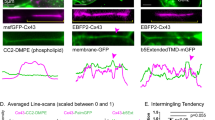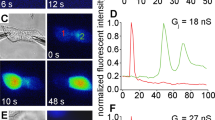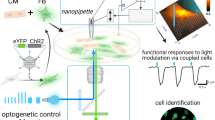Abstract
Using a new class of photo-activatible fluorophores, we have developed a new imaging technique for measuring molecular transfer rates across gap junction connexin channels in intact living cells. This technique, named LAMP, involves local activation of a molecular fluorescent probe, NPE-HCCC2/AM, to optically label a cell. Subsequent dye transfer through gap junctions from labeled to unlabeled cells was quantified by fluorescence microscopy. Additional uncagings after prior dye transfers reached equilibrium enabled multiple measurements of dye transfer rates in the same coupled cell pair. Measurements in the same cell pair minimized variation due to differences in cell volume and number of gap junctions, allowing us to track acute changes in gap junction permeability. We applied the technique to study the regulation of gap junction coupling by intracellular Ca2+ ([Ca2+]i). Although agonist or ionomycin exposure can raise bulk [Ca2+]i to levels higher than those caused by capacitative Ca2+ influx, the LAMP assay revealed that only Ca2+ influx through the plasma membrane store-operated Ca2+ channels strongly reduced gap junction coupling. The noninvasive and quantitative nature of this imaging technique should facilitate future investigations of the dynamic regulation of gap junction communication.
This is a preview of subscription content, access via your institution
Access options
Subscribe to this journal
Receive 12 print issues and online access
$259.00 per year
only $21.58 per issue
Buy this article
- Purchase on Springer Link
- Instant access to full article PDF
Prices may be subject to local taxes which are calculated during checkout




Similar content being viewed by others
References
De Maio, A., Vega, V.L. & Contreras, J.E. Gap junctions, homeostasis, and injury. J. Cell. Physiol. 191, 269–282 (2002).
Bennett, M.V. & Zukin, R.S. Electrical coupling and neuronal synchronization in the Mammalian brain. Neuron 41, 495–511 (2004).
Peracchia, C. (ed.) Gap junctions molecular basis of cell communication in health and disease (Academic Press, 2000).
Goodenough, D.A., Goliger, J.A. & Paul, D.L. Connexins, connexons and intercellular communication. Annu. Rev. Biochem. 65, 475–502 (1996).
Harris, A.L. Emerging issues of connexin channels: biophysics fills the gap. Q. Rev. Biophys. 34, 325–472 (2001).
Wade, M.H., Trosko, J.E. & Schindler, M. A fluorescence photobleaching assay of gap junction-mediated communication between human cells. Science 232, 525–528 (1986).
Van Rijen, H.V.M., Wilders, R., Rook, M.B. & Jongsma, H.J. in Connexin methods and protocols (eds. Bruzzone, R. & Giaume, C.) 269–292 (Humana, Totowa, New Jersey, 2001).
Valiunas, V., Beyer, E.C. & Brink, P.R. Cardiac gap junction channels show quantitative differences in selectivity. Circ. Res. 91, 104–111 (2002).
Wilders, R. & Jongsma, H.J. Limitations of the dual voltage clamp method in assaying conductance and kinetics of gap junction channels. Biophys. J. 63, 942–953 (1992).
Zhao, Y. et al. New caged coumarin fluorophores with extraordinary uncaging cross sections suitable for biological imaging applications. J. Am. Chem. Soc. 126, 4653–4663 (2004).
Davidson, J.S. & Baumgarten, I.M. Glycyrrhetinic acid derivatives: a novel class of inhibitors of gap-junctional intercellular communication. Structure-activity relationships. J. Pharmacol. Exp. Ther. 246, 1104–1107 (1988).
Peters, R. Nuclear envelope permeability measured by fluorescence microphotolysis of single liver cell nuclei. J. Biol. Chem. 258, 11427–11429 (1983).
Biegon, R.P., Atkinson, M.M., Liu, T.F., Kam, E.Y. & Sheridan, J.D. Permeance of Novikoff hepatoma gap junctions: quantitative video analysis of dye transfer. J. Membr. Biol. 96, 225–233 (1987).
Oliveira-Castro, G.M. & Loewenstein, W.R. Junctional membrane permeability: effects of divalent cations. J. Membr. Biol. 5, 51–77 (1971).
Noma, A. & Tsuboi, N. Dependence of junctional conductance on proton, calcium and magnesium ions in cardiac paired cells of guinea-pig. J. Physiol. (Lond.) 382, 193–211 (1987).
Lazrak, A. & Peracchia, C. Gap junction gating sensitivity to physiological internal calcium regardless of pH in Novikoff hepatoma cells. Biophys. J. 65, 2002–2012 (1993).
Spray, D.C., Stern, J.H., Harris, A.L. & Bennett, M.V. Gap junctional conductance: comparison of sensitivities to H and Ca ions. Proc. Natl. Acad. Sci. USA 79, 441–445 (1982).
Firek, L. & Weingart, R. Modification of gap junction conductance by divalent cations and protons in neonatal rat heart cells. J. Mol. Cell. Cardiol. 27, 1633–1643 (1995).
Berridge, M.J. Inositol trisphosphate and calcium signalling. Nature 361, 315–325 (1993).
Takemura, H., Hughes, A.R., Thastrup, O. & Putney, J.W., Jr. Activation of calcium entry by the tumor promoter thapsigargin in parotid acinar cells. Evidence that an intracellular calcium pool and not an inositol phosphate regulates calcium fluxes at the plasma membrane. J. Biol. Chem. 264, 12266–12271 (1989).
Grynkiewicz, G., Poenie, M. & Tsien, R.Y. A new generation of Ca2+ indicators with greatly improved fluorescence properties. J. Biol. Chem. 260, 3440–3450 (1985).
Minta, A., Kao, J.P.Y. & Tsien, R.Y. Fluorescent Indicators For Cytosolic Calcium Based On Rhodamine and Fluorescein Chromophores. J. Biol. Chem. 264, 8171–8178 (1989).
Kwan, C.Y., Takemura, H., Obie, J.F., Thastrup, O. & Putney, J.W., Jr. Effects of MeCh, thapsigargin, and La3+ on plasmalemmal and intracellular Ca2+ transport in lacrimal acinar cells. Am. J. Physiol. 258, C1006–C1015 (1990).
Marsault, R., Murgia, M., Pozzan, T. & Rizzuto, R. Domains of high Ca2+ beneath the plasma membrane of living A7r5 cells. EMBO J. 16, 1575–1581 (1997).
Davies, E.V. & Hallett, M.B. High micromolar Ca2+ beneath the plasma membrane in stimulated neutrophils. Biochem. Biophys. Res. Commun. 248, 679–683 (1998).
Unwin, P.N. & Ennis, P.D. Two configurations of a channel-forming membrane protein. Nature 307, 609–613 (1984).
Muller, D.J., Hand, G.M., Engel, A. & Sosinsky, G.E. Conformational changes in surface structures of isolated connexin 26 gap junctions. EMBO J. 21, 3598–3607 (2002).
Turin, L. & Warner, A.E. Intracellular pH in early Xenopus embryos: its effect on current flow between blastomeres. J. Physiol. (Lond.) 300, 489–504 (1980).
Peracchia, C., Sotkis, A., Wang, X.G., Peracchia, L.L. & Persechini, A. Calmodulin directly gates gap junction channels. J. Biol. Chem. 275, 26220–26224 (2000).
Jurado, L.A., Chockalingam, P.S. & Jarrett, H.W. Apocalmodulin. Physiol. Rev. 79, 661–682 (1999).
DeVries, S.H. & Schwartz, E.A. Hemi-gap-junction channels in solitary horizontal cells of the catfish retina. J. Physiol. (Lond.) 445, 201–230 (1992).
Goodenough, D.A. & Paul, D.L. Beyond the gap: functions of unpaired connexon channels. Nat. Rev. Mol. Cell Biol. 4, 285–294 (2003).
Acknowledgements
This research was supported by a research grant (I–1510) from the Welch Foundation and a Career Development Award from the American Diabetes Associations to W.-H. Li. We thank F. Grinnell for providing primary human fibroblasts. We also thank K. Luby-Phelps, R. Anderson and F. Grinnell for critical comments on the manuscript.
Author information
Authors and Affiliations
Corresponding author
Ethics declarations
Competing interests
The authors declare no competing financial interests.
Supplementary information
Supplementary Fig. 1
Primary human foreskin fibroblasts express connexin 43 and form gap junctions in culture. (PDF 745 kb)
Supplementary Fig. 2
HCCC2 diffuses rapidly intracellularly. (PDF 425 kb)
Supplementary Fig. 3
[Ca2+]i fluctuations in HF by Fura-2 imaging. (PDF 185 kb)
Rights and permissions
About this article
Cite this article
Dakin, K., Zhao, Y. & Li, WH. LAMP, a new imaging assay of gap junctional communication unveils that Ca2+ influx inhibits cell coupling. Nat Methods 2, 55–62 (2005). https://doi.org/10.1038/nmeth730
Received:
Accepted:
Published:
Issue Date:
DOI: https://doi.org/10.1038/nmeth730
This article is cited by
-
OptoGap is an optogenetics-enabled assay for quantification of cell–cell coupling in multicellular cardiac tissue
Scientific Reports (2021)
-
Chloral hydrate decreases gap junction communication in rat liver epithelial cells
Cell Biology and Toxicology (2011)
-
Assaying dynamic cell–cell junctional communication using noninvasive and quantitative fluorescence imaging techniques: LAMP and infrared-LAMP
Nature Protocols (2009)
-
Calcium spikes in a leech nonspiking neuron
Journal of Comparative Physiology A (2009)
-
Function of connexins in the renal circulation
Kidney International (2008)



